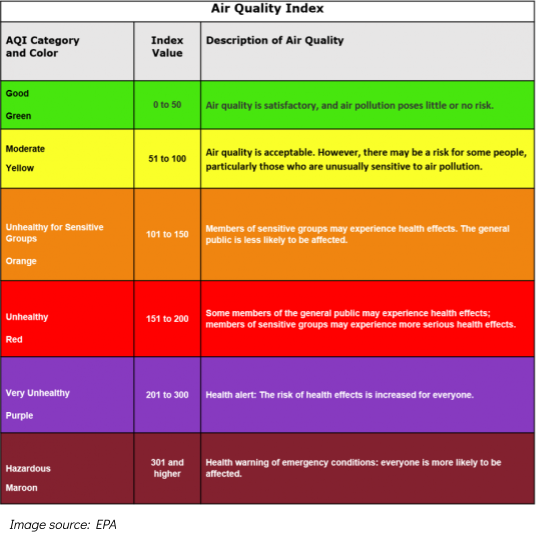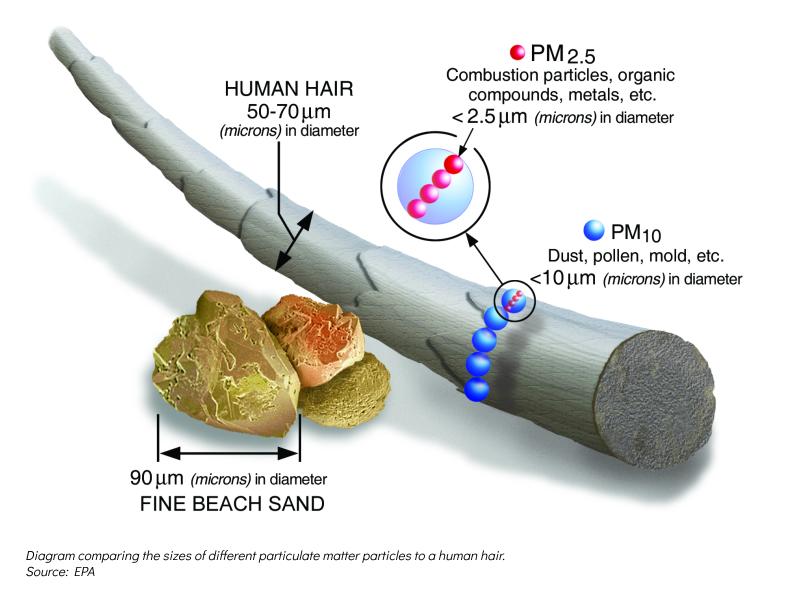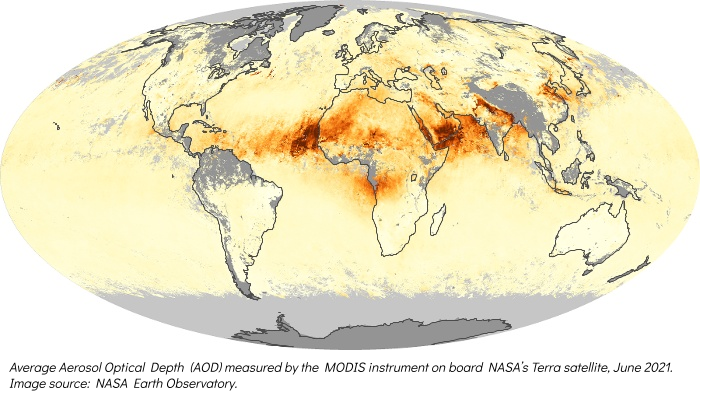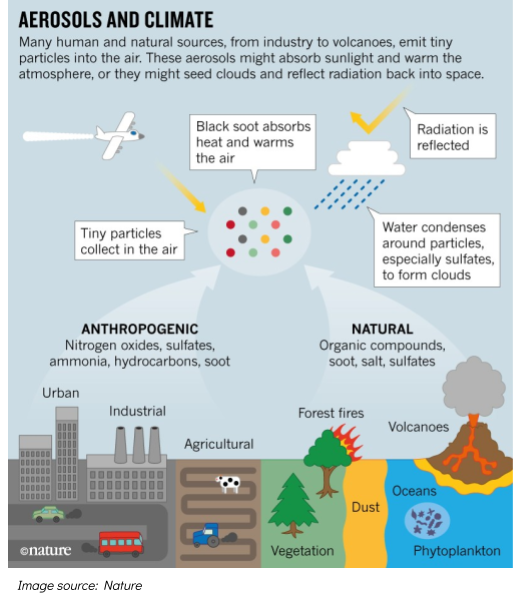Science of Air Quality - Mission Earth
The Science of Air Quality
What is air quality?
Air quality is a measure of the pollution level in the air. Polluted air can be caused by many things. There are manmade and natural sources of emissions. Man made emission include factories, power plants, oil refineries, and combustion of oil and gas. Natural emissions include smoke from fires, gases and ash from volcanic eruptions, blowing dust, and hydrocarbon emissions by some vegetation. Worldwide, air quality is monitored by a network of environmental agencies. These agencies monitor the levels of both primary and secondary pollutants in the atmosphere. The major air pollutants that are monitored include:
-
particulate matter, or aerosols, which are a mixture of solid particles and liquid droplets
suspended in the air. Particulate matter, or PM, are in a range of sizes. Examples of larger
particles (10 microns or smaller) include dust, pollen and mold. Smaller particles (2.5 microns or
smaller) come from combustion or organic compounds. Particulate matter can be both primary and secondary pollutants. -
ground level ozone, a secondary pollutant that forms when nitrogen oxides and volatile organic compounds (emitted by factories, power plants, vehicles, and trees) react in sunlight.
-
carbon monoxide, a primary pollutant, caused by combustion of fossil fuels.
-
sulfur dioxide, a primary pollutant emitted from power plants, factories, and volcanos.
-
nitrogen dioxide, a primary pollutant, also caused by combustion of fossil fuels.
The overall air quality in an area is measured using the Air Quality Index, or AQI. AQI is a unitless number, from 0 to 500, that communicates the health risk caused by the amount of pollution in the air. A reported AQI value can be based on particulate matter levels only, ozone levels only, or a combination of the two.
What is PM2.5?
PM2.5 is very, very small particles or liquid droplets 
that are suspended in the air for a period of time. “PM” means particulate matter. “2.5” indicates the size of the particulate matter: 2.5 microns in diameter or less. (There are approximately 25,000 microns in an inch.) The largest PM2.5 particles are smaller than a human hair; thousands of the smallest PM2.5 particles could fit on the period at the end of a sentence!
PM2.5, as well as larger particulates like PM10, are often referred to as aerosols. Any particles or droplets that are suspended in a gas (the air, in this case) are aerosols. So, PM2.5 is a specific way to refer to a certain size of aerosols.
Aerosols, including PM2.5, come from two sources: naturally occurring sources and anthropogenic (man-made) sources. Naturally occurring aerosols are part of Earth’s climatological and ecological cycles. Some, like smoke from wildfires and dust from dust storms, occur seasonally, or under certain climatic conditions (such as drought). Certain types of vegetation can release chemicals called volatile organic compounds (VOCs), which can quickly react chemically and form aerosols, causing haze. (This phenomenon is where the Great Smoky Mountains get their name!) Other sources of natural aerosols, like volcanic eruptions, are less predictable, but can have global effects.

Anthropogenic sources of aerosols are the result of human activity. The main source of anthropogenic aerosols is the combustion of fossil fuels (coal, oil and natural gas) for transportation, generation of heat and power, and operation of industrial facilities. Anthropogenic sources of air pollution are generally emitted from a specific location, so they are known as point sources of pollution. Knowing specific locations of point sources (such as factories or power plants) is very useful when studying the concentration of PM2.5 in a specific area.

Aerosols scatter sunlight traveling through Earth’s atmosphere, making the air appear dirty or hazy.
Sun photometers measure Aerosol Optical Thickness (AOT), which determines how much the sunlight is being affected by particulate matter in the atmospheric column. Measurements of AOT at different wavelengths can provide information about the size and type of aerosols in the atmosphere.

Why do we study PM2.5?

Aerosols, including PM2.5, are measured in two ways: by satellites in space and by instruments on the ground. Many of these measurements are of Aerosol Optical Thickness (AOT), sometimes referred to
as Aerosol Optical Depth (AOD), which determines how much sunlight is being affected by particulate matter in the air. Measurements of AOT made from space can be compared to measurements made with ground-based instruments (including instruments used by research and community scientists). Additionally, since aerosols scatter and reflect sunlight as it travels through the atmosphere, large amounts of aerosols can sometimes be mistaken for clouds by satellites. Observations of clouds, sky color and sky clarity by observers on the ground can help to validate satellite observations.

The impact of aerosols on the atmosphere is one of the most significant and uncertain aspects of climate change projections. Aerosols impact climate in many ways, including through direct scattering of sunlight, absorption of incoming solar radiation and the formation of clouds and precipitation. Therefore, a better understanding of aerosols - including PM2.5 - can help to improve climate models.
The impact of aerosols on human health is also a particular concern. Particulate matter, PM2.5 in particular, can be inhaled, getting deep into the lungs (and into the bloodstream, in some cases). Exposure to PM2.5 can cause a variety of health issues. Short-term exposure to particulate matter can cause eye, nose, throat and lung irritation, coughing, sneezing or shortness of breath. Exposure to particulate matter
for longer periods of time can aggravate asthma and other respiratory and heart problems. Longer-term exposure has also been associated with chronic bronchitis, reduced lung function, and increased mortality from lung cancer and heart disease. Monitoring PM2.5 using existing instruments (such as those used by the Environmental Protection Agency) as well as small, privately-owned sensors (like the PurpleAir) can help individuals and communities identify areas that have elevated levels of particulate matter pollution.
PM2.5 can have a significant impact on air quality, the Earth’s climate, and human health. Studying PM2.5 helps scientists make better predictions about where particulate matter might travel, and its effects on human health and the health of our environment. Measurements of PM2.5 can also help scientists validate satellite observations, study local air quality events where there are no other instruments and explore remote locations where data are rare.





